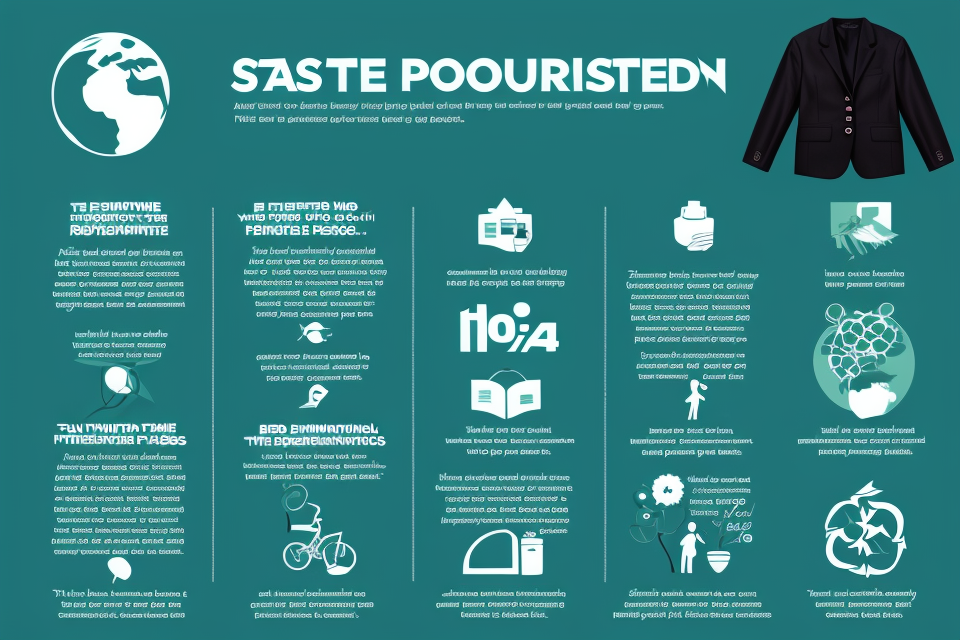
The world of fashion is an ever-evolving industry that is constantly changing and adapting to new trends. However, with the rise of fast fashion, the industry has come under scrutiny for its impact on the environment. But can fast fashion ever be sustainable? This question has sparked a heated debate among experts and consumers alike. In this article, we will explore the complexities of fast fashion and sustainability, and delve into the possibilities of a green revolution in the fashion industry.
The Fast Fashion Dilemma
How Fast Fashion is Threatening the Environment
- In recent years, fast fashion has emerged as a major contributor to environmental degradation.
- The rapid pace of production and consumption in the fast fashion industry has led to an exponential increase in greenhouse gas emissions, water pollution, and textile waste.
- This section will delve into the various ways in which fast fashion is threatening the environment.
Water Pollution
- The textile industry is one of the largest consumers of water globally, with fast fashion companies being major contributors to water pollution.
- In many countries, including China, India, and Bangladesh, the textile industry is one of the leading polluters of rivers and streams.
- The use of synthetic fibers and dyes in fast fashion production requires large amounts of water, and the wastewater that is generated contains harmful chemicals that can cause severe environmental damage.
- According to a report by the World Wildlife Fund, it takes approximately 2,700 liters of water to produce a single cotton T-shirt, which is enough to sustain one person for about five years.
- This highlights the urgent need for sustainable practices in the fast fashion industry to mitigate the impact of water pollution.
High Energy Consumption
- The fast fashion industry is also a significant contributor to energy consumption, with factories and transportation requiring large amounts of energy to operate.
- The production of clothing, from growing cotton to manufacturing and transportation, requires a significant amount of energy, with estimates suggesting that the industry contributes to about 10% of global carbon emissions.
- Fast fashion companies often rely on fast transportation to move goods quickly, which leads to a higher carbon footprint.
- In addition, the use of synthetic fibers in fast fashion production requires large amounts of energy to produce, further contributing to the industry’s carbon emissions.
- There is a need for fast fashion companies to adopt sustainable practices that reduce their energy consumption and carbon footprint.
Textile Waste and Landfills
- Fast fashion has also led to an exponential increase in textile waste, with consumers constantly seeking new trends and styles.
- According to a report by the Ellen MacArthur Foundation, the fashion industry produces 92 million tons of waste annually, with fast fashion companies contributing significantly to this waste.
- The majority of this waste ends up in landfills, where it takes hundreds of years to decompose, releasing harmful chemicals into the environment.
- The fast fashion industry needs to adopt sustainable practices that reduce waste and promote recycling and upcycling.
- Initiatives such as using organic cotton, implementing circular economy models, and encouraging consumers to purchase fewer, higher-quality garments can help reduce textile waste.
In conclusion, the fast fashion industry is a major contributor to environmental degradation, with water pollution, high energy consumption, and textile waste being significant concerns. The industry needs to adopt sustainable practices that reduce its impact on the environment, such as using organic cotton, implementing circular economy models, and encouraging consumers to purchase fewer, higher-quality garments.
The Dark Side of Fast Fashion: Human and Labor Rights Violations
Unethical Labor Practices
Fast fashion has been accused of engaging in unethical labor practices that exploit workers, particularly in developing countries. These practices include long working hours without overtime pay, forced labor, and the use of child labor. In some cases, workers are paid below the minimum wage, and their working conditions are often unsafe and unhygienic. Many fast fashion brands have been accused of outsourcing production to factories that engage in these practices, which can lead to the exploitation of workers and the violation of their human rights.
Low Wages and Poor Working Conditions
Fast fashion workers often face low wages and poor working conditions. Many workers are paid below the minimum wage, and some are not even provided with basic amenities such as clean drinking water or proper sanitation facilities. The long working hours and physically demanding nature of the job can also lead to worker fatigue and injury. Some workers have even reported being forced to work overtime without being paid for their efforts.
Child Labor and Forced Labor
Child labor is another serious issue in the fast fashion industry. Many factories in developing countries employ children to work long hours for low wages. This can lead to the exploitation of children, who may be forced to work in dangerous conditions or be subjected to physical abuse. In addition, forced labor is also a concern in the fast fashion industry, with some workers being forced to work against their will under threat of violence or other penalties.
Overall, the fast fashion industry has been accused of engaging in unethical labor practices that violate human rights and exploit workers. These practices are often facilitated by the industry’s focus on low prices and fast production times, which can lead to the use of cheap labor and the prioritization of profits over worker well-being. As a result, there is a need for greater transparency and accountability in the fast fashion industry to ensure that workers are treated fairly and human rights are respected.
The Quest for Sustainable Fashion
Understanding Sustainable Fashion: Principles and Practices
Reduce, Reuse, and Recycle
Sustainable fashion encompasses various principles and practices aimed at minimizing the negative impact of the industry on the environment. One of the primary principles is the concept of reduce, reuse, and recycle. This means that instead of continuously producing new clothing items, the focus should be on extending the lifecycle of existing garments. Encouraging consumers to repair, upcycle, and repurpose their clothing, rather than discarding it, is an essential aspect of sustainable fashion. Additionally, recycling textile waste into new fabrics and fibers can help reduce the demand for virgin materials and decrease the carbon footprint associated with the production process.
Eco-Friendly Materials and Production Techniques
Sustainable fashion also emphasizes the use of eco-friendly materials and production techniques. This includes choosing organic cotton, hemp, linen, and other natural fibers that require fewer chemicals and pesticides during production. Furthermore, innovative technologies such as digital printing, 3D printing, and laser cutting can help reduce water and energy consumption while minimizing textile waste.
Circular Fashion and Closed-Loop Systems
Circular fashion is another crucial principle of sustainable fashion, which promotes the creation of closed-loop systems that minimize waste and maximize resource efficiency. This involves designing garments that can be easily disassembled and recycled, as well as implementing systems for collecting and processing textile waste. Collaboration between designers, manufacturers, and consumers is essential to create a circular fashion system that minimizes the environmental impact of the industry.
In conclusion, understanding the principles and practices of sustainable fashion is crucial for creating a more environmentally friendly and ethical fashion industry. By implementing reduce, reuse, and recycle practices, using eco-friendly materials and production techniques, and embracing circular fashion and closed-loop systems, the fashion industry can work towards a more sustainable future.
The Rise of Sustainable Fashion Brands and Initiatives
-
Ethical and Environmentally Conscious Designers
- Many fashion designers have become more conscious of the environmental and social impact of their industry, leading to a rise in ethical and environmentally conscious brands.
- These designers are using sustainable materials, reducing waste, and promoting fair labor practices in their supply chains.
- Some examples of such brands include Everlane, Patagonia, and Eileen Fisher.
-
Upcycling and Repurposing
- Upcycling and repurposing are becoming increasingly popular in the fashion industry as a way to reduce waste and promote sustainability.
- Designers are using old clothing and materials to create new pieces, reducing the need for new resources and lowering the carbon footprint of the fashion industry.
- Examples of brands that utilize upcycling and repurposing include Re/Done, Renewal, and Reuse.
-
Sustainable Materials and Certifications
- The use of sustainable materials is another important aspect of the rise of sustainable fashion brands and initiatives.
- Many designers are using organic cotton, recycled polyester, and other eco-friendly materials to create their products.
- Additionally, some brands are obtaining certifications such as the OEKO-TEX Standard, which ensures that the materials used are safe for the environment and human health.
- Examples of brands that prioritize sustainable materials include H&M Conscious, Puma, and Adidas.
The Influence of Consumers and Societal Shifts on Sustainable Fashion
The Growing Demand for Sustainable Fashion
- Consumers are becoming increasingly conscious of the environmental and social impact of their purchasing decisions, leading to a growing demand for sustainable fashion.
- This demand is driven by a desire for more ethical and environmentally friendly clothing options, as well as a growing awareness of the negative impact of fast fashion on the environment and society.
- As a result, sustainable fashion is no longer a niche market, but a mainstream trend that is gaining momentum and changing the way people think about fashion.
The Role of Social Media and Influencers
- Social media platforms such as Instagram and TikTok have played a significant role in driving the demand for sustainable fashion by providing a platform for sustainable fashion influencers to share their message with a wider audience.
- These influencers have helped to raise awareness about the negative impact of fast fashion and the importance of sustainable fashion, reaching millions of followers and inspiring them to make more conscious fashion choices.
- Through their content, they promote sustainable fashion brands, offer tips on how to shop sustainably, and share their own personal experiences with sustainable fashion.
The Importance of Education and Awareness
- Education and awareness are crucial in the quest for sustainable fashion, as they help to inform consumers about the negative impact of fast fashion and the importance of making more conscious fashion choices.
- This includes educating consumers about the environmental and social costs of fast fashion, as well as providing information on how to shop sustainably and make more ethical fashion choices.
- Through education and awareness, consumers can become more informed and empowered to make a positive impact on the fashion industry and the environment.
The Challenges of Making Fast Fashion Truly Sustainable
Balancing Fast Fashion’s Business Model with Sustainability
The Struggle to Maintain Profitability
Fast fashion businesses are driven by the constant pursuit of profit, and this goal often conflicts with the environmental and social goals of sustainability. For example, companies may resist investing in costly sustainable materials or practices if they do not see an immediate return on investment. This can make it difficult to prioritize sustainability, especially for smaller companies that may have less financial cushion.
The Challenge of Meeting Consumer Demands
Consumers play a crucial role in driving demand for fast fashion, and this demand can be difficult to reconcile with sustainability goals. Consumers expect fast fashion to be cheap and accessible, and this can make it challenging for companies to prioritize sustainability. For example, companies may be hesitant to increase prices or limit production in order to reduce waste and emissions, as this could lead to lost sales and customer dissatisfaction.
The Role of Innovation and Technology
Innovation and technology can play a key role in helping fast fashion companies balance their business model with sustainability. For example, companies can invest in new materials or production techniques that reduce waste and emissions. They can also use technology to track and improve their supply chain, reducing the risk of exploitation and environmental harm. However, these innovations and technologies can be costly, and companies may be hesitant to invest in them if they do not see a clear return on investment. Additionally, these technologies may not be accessible to all companies, especially smaller businesses that may lack the resources to invest in them.
Overcoming the Systemic Barriers to Sustainable Fast Fashion
Navigating Complex Supply Chains
One of the primary challenges in making fast fashion more sustainable is navigating the complex supply chains that underpin the industry. Fast fashion companies typically source materials and components from a vast array of suppliers, often located in different countries and operating under varying environmental regulations. This complexity makes it difficult to track the origin of materials and ensure that they are sourced in an environmentally responsible manner. Moreover, the fast pace of fashion production often leads to a lack of transparency, with suppliers pressured to meet tight deadlines and cut corners to reduce costs. As a result, there is a significant risk of environmental damage, including deforestation, water pollution, and greenhouse gas emissions.
Tackling the Textile Industry’s Environmental Impact
Another significant barrier to sustainable fast fashion is the environmental impact of the textile industry as a whole. The production of textiles requires large amounts of water, energy, and chemicals, which can lead to significant environmental degradation if not managed properly. For instance, cotton farming is a water-intensive process that can deplete aquifers and contribute to water scarcity in some regions. Additionally, the use of synthetic fibers such as polyester and nylon is often associated with high energy consumption and the release of harmful chemicals into the environment. Therefore, to make fast fashion more sustainable, the industry must address these environmental impacts at every stage of the supply chain, from the sourcing of raw materials to the disposal of finished products.
Encouraging Collective Action and Accountability
A third systemic barrier to sustainable fast fashion is the lack of collective action and accountability within the industry. While some fast fashion companies have made commitments to sustainability, there is a need for a more coordinated and collaborative approach to address the industry’s environmental impact. This requires a shift in mindset from a competitive, profit-driven model to a more cooperative, sustainability-focused approach. For instance, fast fashion companies could work together to develop more sustainable materials and production methods, share best practices, and encourage consumers to adopt more sustainable behaviors. Moreover, there is a need for greater transparency and accountability throughout the supply chain, with companies taking responsibility for the environmental impact of their products and working to address any negative impacts.
Overall, overcoming these systemic barriers to sustainable fast fashion will require a concerted effort from all stakeholders in the industry, including fashion companies, suppliers, consumers, and policymakers. By working together to address the complex challenges facing the industry, it may be possible to create a more sustainable and environmentally responsible fast fashion sector.
The Role of Regulation and Policy in Driving Sustainable Change
The Need for International Standards and Regulations
One of the key challenges in making fast fashion truly sustainable is the need for international standards and regulations. With the fast fashion industry being a global phenomenon, it is crucial to have a uniform set of guidelines that apply to all players in the industry. This will help to ensure that all companies are working towards the same sustainability goals and that there is a level playing field for all. However, developing such standards and regulations is a complex process that requires cooperation and coordination among different countries and stakeholders.
Encouraging Corporate Responsibility
Another challenge is encouraging corporate responsibility among fast fashion companies. While some companies have made significant strides in sustainability, others have been slow to adopt environmentally friendly practices. To drive sustainable change, there needs to be a greater emphasis on corporate responsibility and accountability. This can be achieved through a combination of carrots and sticks, such as offering incentives for sustainable practices and imposing penalties for non-compliance.
Promoting Transparency and Accountability
Promoting transparency and accountability is also critical in driving sustainable change in the fast fashion industry. This includes ensuring that companies disclose their environmental impact and supply chain practices, as well as providing information on the origin of their materials and products. By promoting transparency, consumers can make informed choices about the products they purchase and hold companies accountable for their actions. Additionally, transparency can help to identify areas where improvements can be made and encourage companies to take a more proactive approach to sustainability.
The Future of Fast Fashion: Can Sustainability Prevail?
The Path to a Greener Future for Fast Fashion
- Embracing Sustainable Practices and Innovations
Fast fashion brands must shift their focus towards sustainable practices and innovations. This includes investing in eco-friendly materials, adopting circular fashion models, and minimizing waste. By prioritizing sustainable practices, brands can reduce their environmental impact and improve their reputation. - Prioritizing Transparency and Accountability
Fast fashion brands must be transparent about their supply chains and production processes. This includes disclosing information about raw material sourcing, manufacturing processes, and labor practices. By being transparent, brands can build trust with consumers and demonstrate their commitment to sustainability. - Fostering Collaboration and Partnerships
Collaboration and partnerships between fast fashion brands, NGOs, and sustainability organizations can drive progress towards a greener future. This includes sharing best practices, developing new technologies, and working together to address industry-wide challenges. By fostering collaboration, brands can leverage the expertise of others and drive systemic change in the industry.
The Role of Education and Consumer Behavior in Shaping the Future
Empowering Consumers to Make Sustainable Choices
Education plays a critical role in shaping consumer behavior towards sustainability. By providing information on the environmental and social impacts of fast fashion, consumers can make informed choices about their purchases. This can include highlighting the benefits of investing in high-quality, long-lasting garments, the importance of proper care and maintenance, and the value of thrifting and second-hand shopping. Additionally, education can promote the concept of a circular fashion economy, where consumers are encouraged to recycle, upcycle, and repurpose their clothing.
Promoting a Culture of Responsibility and Sustainability
A cultural shift towards sustainability and responsibility is essential for the future of fast fashion. This involves not only changing consumer behavior but also encouraging fashion brands and manufacturers to adopt more sustainable practices. By fostering a culture of awareness and responsibility, consumers can demand transparency from fashion brands and support those who prioritize sustainability in their operations. This can include advocating for ethical labor practices, reducing waste, and using eco-friendly materials.
Encouraging Lifelong Learning and Adaptability
As the fashion industry evolves, it is crucial for consumers to stay informed and adapt to new sustainable practices. Lifelong learning and adaptability are essential in fostering a culture of sustainability. This can involve providing ongoing education on the latest sustainable fashion trends, technologies, and best practices. By encouraging a culture of continuous learning, consumers can stay ahead of the curve and contribute to a more sustainable future for fashion.
Overall, the role of education and consumer behavior in shaping the future of fast fashion cannot be overstated. By empowering consumers to make sustainable choices, promoting a culture of responsibility and sustainability, and encouraging lifelong learning and adaptability, the fashion industry can move towards a more sustainable and responsible future.
FAQs
1. What is fast fashion?
Fast fashion refers to the mass production of clothing and accessories that mimic current fashion trends at a low cost. The aim is to quickly get these trends into stores and onto consumers, often at the expense of quality and durability. Fast fashion brands rely on a continuous cycle of production and consumption, which can lead to a high environmental impact.
2. What are the environmental impacts of fast fashion?
The environmental impacts of fast fashion are significant. Fast fashion contributes to greenhouse gas emissions, waste, and water pollution. The fashion industry is responsible for approximately 10% of global carbon emissions, with fast fashion making up a large portion of this. In addition, fast fashion often relies on unsustainable and environmentally damaging materials, such as polyester and other synthetic fibers.
3. Can fast fashion ever be sustainable?
While it may be difficult, fast fashion can be made more sustainable. Some brands have made efforts to use more eco-friendly materials, such as organic cotton and recycled polyester. Others have implemented practices like water recycling and solar power in their manufacturing processes. However, the fast fashion model itself, which relies on rapid production and consumption, is inherently unsustainable.
4. What are some alternatives to fast fashion?
There are several alternatives to fast fashion that prioritize sustainability. These include slow fashion, which emphasizes quality and durability over trendiness, and ethical fashion, which prioritizes fair labor practices and sustainable materials. Additionally, rental and second-hand clothing services can help reduce waste and encourage a more circular economy.
5. What role do consumers play in making fast fashion more sustainable?
Consumers have a significant role to play in making fast fashion more sustainable. By choosing to buy from sustainable and ethical brands, consumers can vote with their wallets and encourage change in the industry. Additionally, consumers can extend the life of their clothing by taking care of their garments and repairing them when necessary, rather than constantly buying new items.
6. What steps can fast fashion brands take to become more sustainable?
Fast fashion brands can take several steps to become more sustainable. This includes using eco-friendly materials, implementing sustainable manufacturing practices, and promoting transparency in their supply chains. Brands can also encourage consumers to make more sustainable choices, such as by offering rental or second-hand options. Additionally, brands can work to reduce their carbon footprint by investing in renewable energy and reducing waste in their operations.


